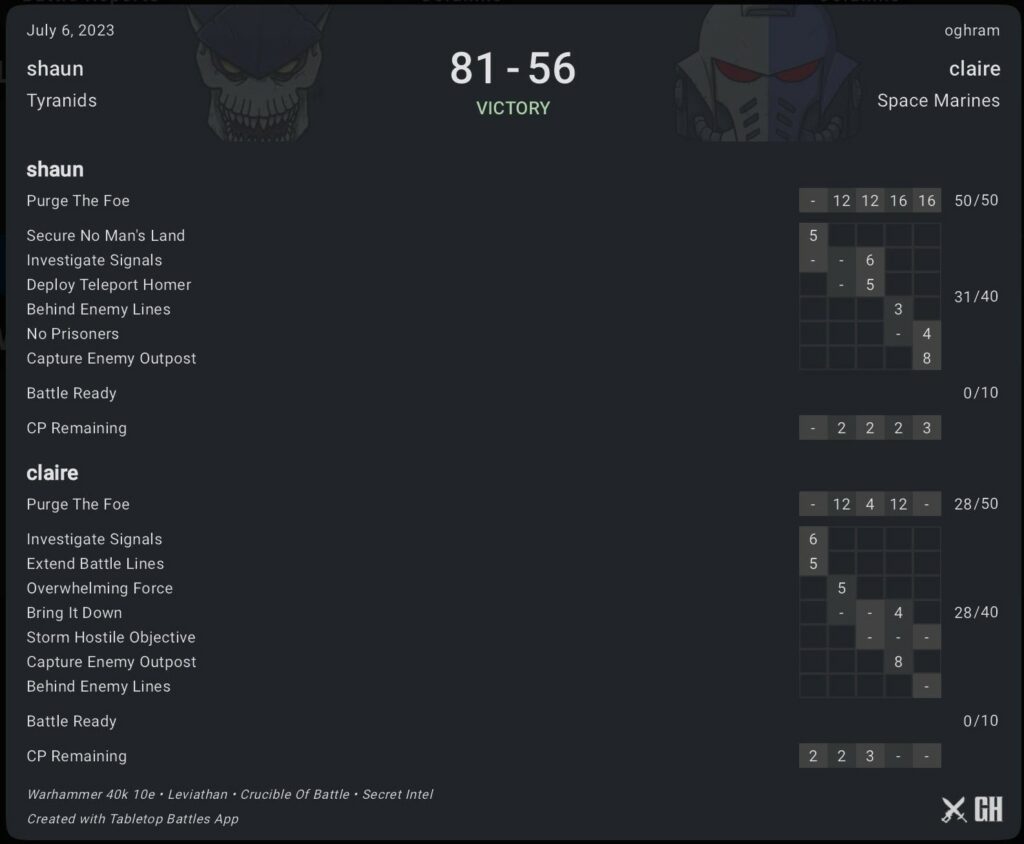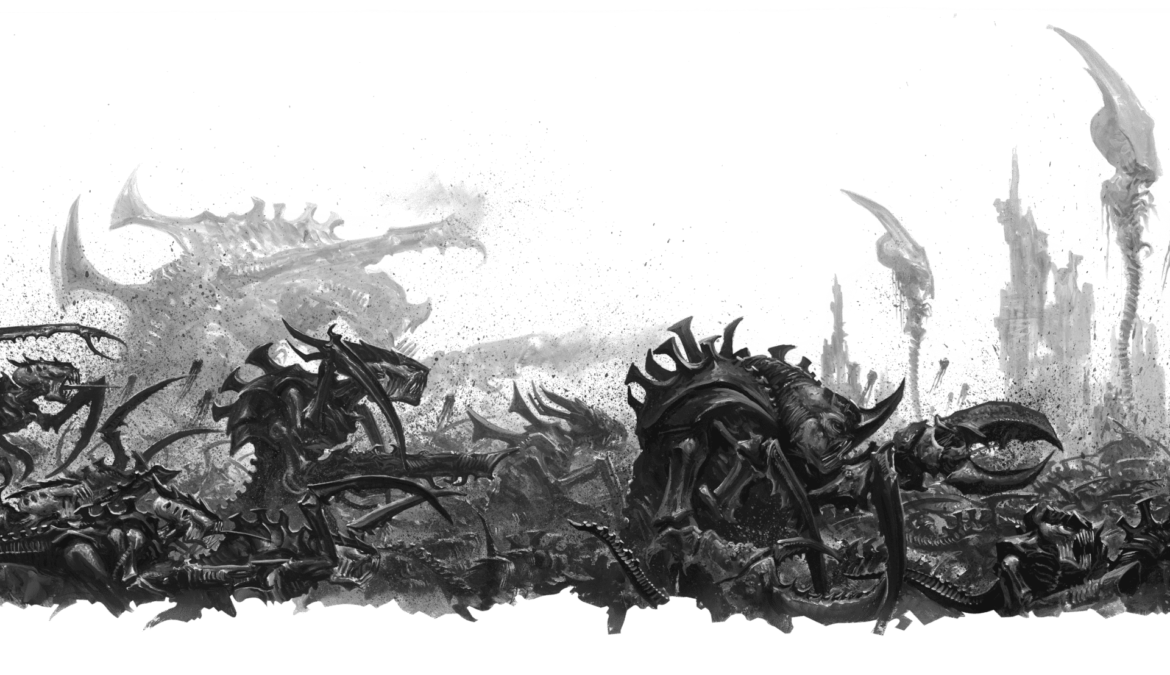Games Workshop launched the 10th edition of Warhammer 40,000 just two weeks ago, including a box set dubbed Leviathan. This contained a substantial collection of posthuman Space Marine and chitinous alien Tyranid miniatures; about 75 models. Thanks to a friend I was able to snag a copy of Leviathan, and spent the launch weekend building models and reading the new rules. This post is a round-up of assorted reactions to the new edition, including my thoughts after playing a couple of games, and my feelings about the contents of Leviathan.
Let’s start with the box set, about which I’ll be brief. Since pre-orders sold out rapidly, at this point the only copies available will be via third-party sellers, and so there’s not much reason to dwell on it. So, here you get approximately fifty Tyranid models, approximately twenty-five Space Marine models, a hardback book containing the 10th edition rulebook and Crusade rulebook in one, a pack of Leviathan mission cards, and a transfer sheet. There are no dice, measuring sticks or other ‘starter’ items, as this limited run box set is clearly aimed at existing fans more than new players.
The rulebook including the new Crusade rules is really nice, as this more narratively oriented way of playing the game is something I’m interested in. The book itself is hefty AF, although the core rules are covered in just 40 to 50 pages; just a fraction of the contents. There’s otherwise a lot of lore, artwork and miniature photography, as you’d expect. It’s a nice book, well laid out, and the Core Rules are mostly well explained. I also like the included pack of mission cards; like the Crusade rules, this is something I’d otherwise have bought separately. These cards are a way to easily generate a variety of mission objectives, rules and deployment areas, giving games plenty of variety. I’ll speak of these again later.
I felt the absence of the new style of ‘index cards’ – double-sided cards containing all the status and rules for any given unit – for the models included in the box set. These feel like they’d have been an easy inclusion, and without them you’re left referring to a downloaded PDF or the official app. This isn’t ideal, but more on that later. Reference sheets for the core rules would also have been a nice inclusion, but not including them does make sense for a box set not targeting new players.
As for the miniatures… well, let’s get a couple of minor grumbles out of the way first. There’s no scenery included, but honestly the box was already packed to the brim. There are three models that serve no real purpose – two Tyranid Neuroloids and one homing beacon – but I shouldn’t really complain about three small bonus miniatures. Finally, the lack of a third base of Rippers is a bit odd, as you only get two but need three for a unit. They’re included on the Termagant sprues, of which you get two, so it makes some sense. I guess I’ll be buying more Termagants…
Now to the positive. As is generally the case with new Games Workshop miniatures, the sculpts are fantastic, with impressive levels of detail, and the manufacturing is top-class. Mould lines are vanishingly faint, although I still diligently cleaned up what was visible during building. All these models are push-fit, which I’ve had issues with in the past. Blackstone Fortress and the 8th edition Dark Imperium set also had similar push-fit miniatures, and with a lot of those I had issues pushing pieces together. This usually resulted in substantial gaps between pieces that looked terrible, or the risk of snapping plastic when trying to force parts apart again. Those experiences led me to cut away the push-fit pegs and just glue the parts instead. With Leviathan, I push-fitted almost everything, only using glue on a few occasions, and only trimming off pegs on a half-dozen models at most. Push-fit models remain divisive, as they generally involve monopose sculpts and limited build options, but at least with these the process of assembly went well.
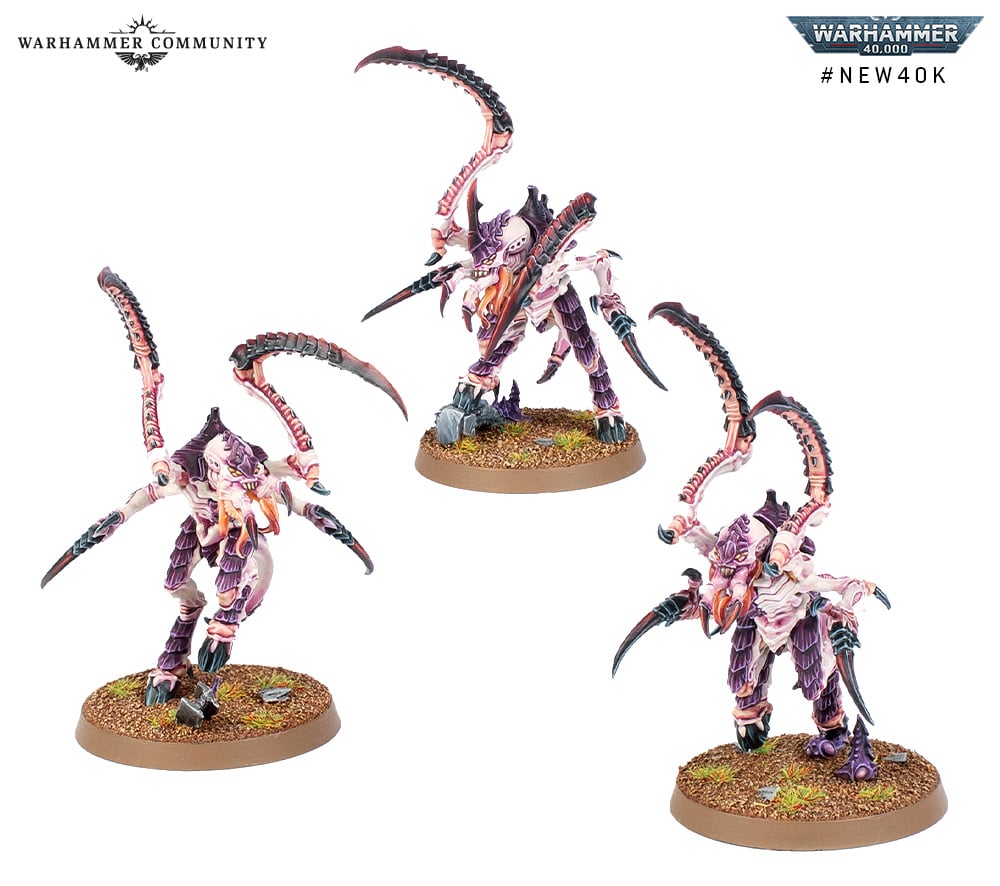
I’m a particular fan of the new Von Ryan’s Leapers – all spines and mouth tentacles and wiry limbs – and the new Screamer Killer, with its odd tribute to male pattern baldness. The Winged Tyranid Prime is also a lovely model. I like the redesigned Terminators, which remain true to the classic original design, but upscale and modernise it. I’m not super keen on the Ballistus Dreadnought, but that’s mostly because I think the entire design is a bit silly. It has no arms; what happens when it gets knocked down?
Now to the game itself. My feeling is that this is cleaner and brisker than 9th edition. I need to caveat this upfront and clarify that I only played a couple of games of 9th edition, and both at a small scale. But in both of those games referencing stratagems and contextual special rules and things that changes across turns and phases got terribly confusing. In one match where I took just four or five units, I had a full sheet of A4 just listing summaries of stuff that should happen at different times. I still forgot a lot. Many rules are referenced in different locations, so – for example – for my Blood Angels I might find myself referencing three different physical books, plus an app, plus my own notes. This… kinda sucks, frankly. I’m sure it gets easier if you play regularly, but it should be obvious that this kind of crap is a barrier to new and more casual players.
With 10th, the pre-release marketing made much of the desire to streamline the game, to simplify various steps, and to consolidate information and rules relevant to units onto index cards for ease of reference. I’ve yet to actually use these index cards – my pre-order of those has yet to arrive – but after playing a Combat Patrol game and a 1000pts Incursion game, I’m already feeling that tapping endlessly back and forth between tabs and nested menus in an app to reference rules is very tedious. My hope is that the index cards solve that problem.
Our first Combat Patrol game didn’t suffer so much with this problem, although there was still a bit of tapping back and forth in the app. Each faction has its unique Combat Patrol rules, stratagems and datasheets collected in one part of the app, and my partner and I found that this was a good way to play a small, introductory game that resembles a full-sized game in most of the ways that matter. (Among the contents of Leviathan are everything you need for a Space Marine and a Tyranid combat patrol – I built these models first!)
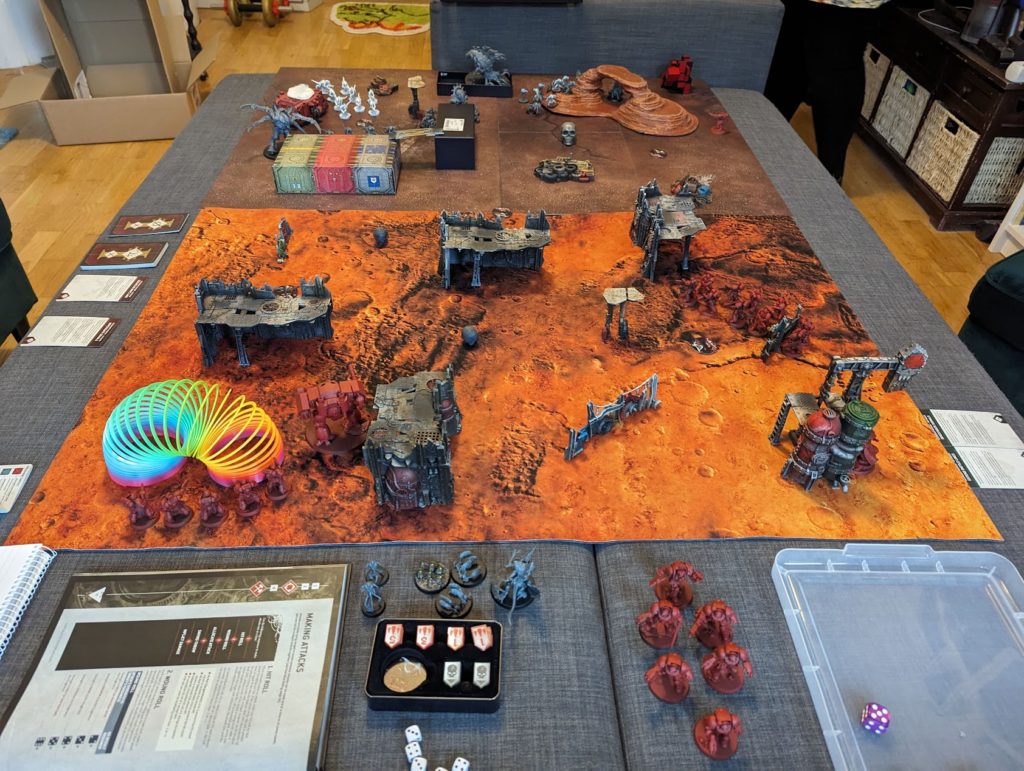
As previously mentioned, we liked what we saw of the mission cards after using them in our larger game. We drew cards to generate our deployment zones, special rules that would be in effect during the game, and our primary mission objectives. We re-drew one card after agreeing that what we’d drawn was a bit too complex for our first large game. After that, we both decided to try the more dynamic ‘Tactical Mission’ method for our secondary objectives. This means that, rather than selecting several fixed secondary objective cards and using those throughout, we’d draw and select secondaries from the deck. This definitely introduced some more reactive play, as we dynamically adjusted our plans to achieve new goals and deny our opponent theirs.
The simplified stat lines felt fine to me. They’re now more in line with what is used in Kill Team than the classic Rogue Trader-derived stat lines. Some stats moved to weapons, and what remains is a clean and simple list of relevant unit stats. I am fine with this.
The new ‘OC’ or objective control stat is a smart edition; contested objectives are no longer a simple all-or-nothing calculation based on the old ‘ObSec’ rule, but now a calculation based on individual models and their OC stat. This is more granular, but in a simple way that feels more interesting to me than ObSec. The Leadership stat also has a new lease on life, as it’s used for battleshock tests – a mechanic replacing morale. Failing a battleshock test means the unit cannot be effected by stratagems – powerful special abilities that players spend command points to use – and cannot exert objective control. This, again, is more interesting to me than morale was, which essentially just killed off additional models from a unit. You do now end up with more fragments of weakened units on the table, with morale not cleaning up so many loose ends. And battleshocked units being unable to secure objectives has had in-game impact for us already. Nice!
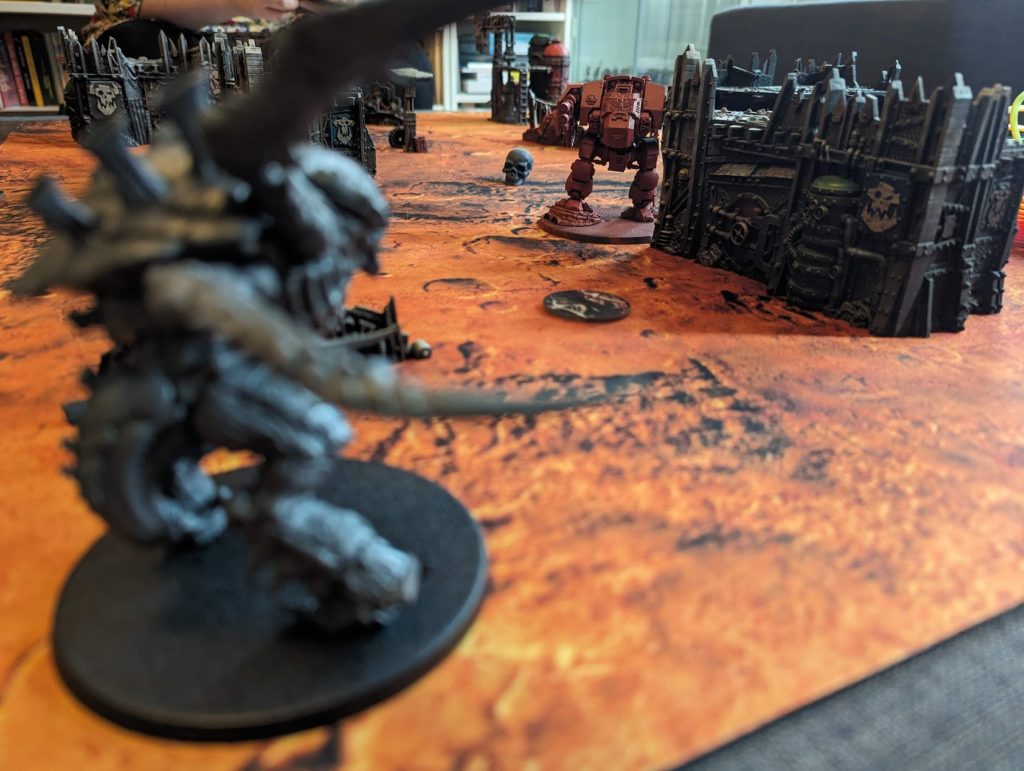
We did run into a few points of contention and confusion. My partner remains a bit puzzled about the distinction between Critical and Mortal Wounds, and also the Strength vs Toughness calculations. These things are clear to me, but she’s not read the rulebook, and evidently I’m not describing them well enough! We were also uncertain about the definition of “corner” for a particular secondary mission, Investigate Signals. It states a unit should be with 9” of a corner to do this. My partner assumed this meant a literal board corner, whereas I initially interpreted it to mean a quadrant of the board – since the only other place I’d seen the word “corner” used was to describe deployment layouts, where each player’s “corner” refers to an entire quadrant of the board. I now think she is correct, but this is pretty ambiguous.
As to the Leviathan models used in battle against one another… I’d say the balance is decent. I’m certainly no expert, but from the games we’ve played and with a little extrapolation, I’d say the forces can fight close battles! In points terms, the Marines here are almost 1000 pts exactly, whereas the Tyranids are around 800 pts. To balance them out we used a squad of Hormagaunts I’d already bought, used a base of Necron Scarabs so we could field a proper Ripper Swarm, and excluded the Apothecary Biologis from the Marine side.
With that caveat aside, the Marines are weak at controlling and contesting objectives on a 44 x 60 board, just because there are so few of them and terminators are slooooow. They also don’t have a lot of tools for dealing with tough monsters (but what they do have can shred). As for the Tyranids, they lack a lot of tools for dealing with the Terminators and Dreadnought, but they do have some options, primarily the Screamer-Killer. The Marines have plenty of options for dealing with Tyranid swarms, whereas the Tyranids have the numbers of contest objectives across the board, and can use their chaff units to cover for the hard-hitting bugs.
I’ll leave you with this screengrab, summarising the results of our 1000 point Incursion game (courtesy of the rather good Goonhammer Tabletop Battles app). It was a win for the Tyranids, but the Marines held the lead for the first two rounds, and it wasn’t conclusive until the fifth and final round began – which was a quick turn to play, with both of us reduced to just a few units. We had a lot of fun, and look forward to a rematch – perhaps with some painted models!
